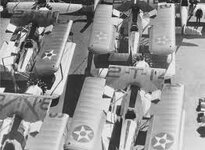Basically - a scenario where USN adopts the navalized Curtiss fighters instead of the F2A/F4F/FM. The number of the respective A/C delivered is in the ballpark. The newly fanged naval fighters can receive suitable engine upgrades as they are available, ie. the 2-stage R-1830 on these fighters is also good to go (talk by late 1941). Same with later R-1820s (some time mid-1943?). Yes, V-1710 is still very much in play.
Folding wings also get introduced, perhaps by early 1942, ie. similar as with the F4F-4.
Protection for pilot and fuel, as well as drop tank installation are introduced by some time 1941, ie. more or less as it was the case historically.
Will the USN be better off, or worse off with the alternative fighters vs. the historical set-up?
Folding wings also get introduced, perhaps by early 1942, ie. similar as with the F4F-4.
Protection for pilot and fuel, as well as drop tank installation are introduced by some time 1941, ie. more or less as it was the case historically.
Will the USN be better off, or worse off with the alternative fighters vs. the historical set-up?



